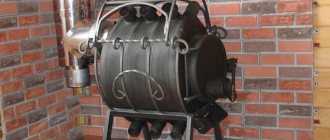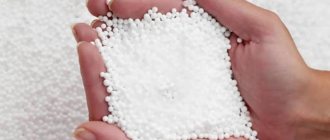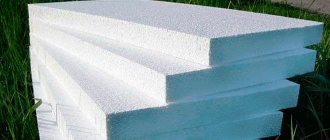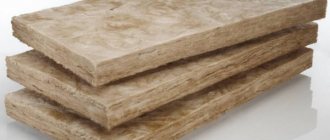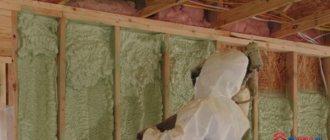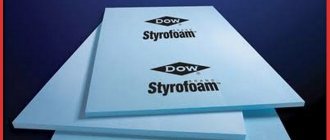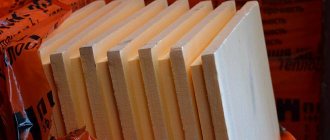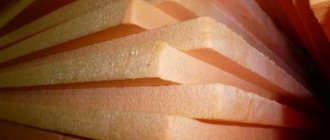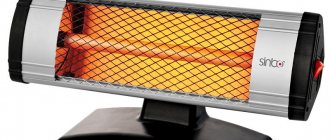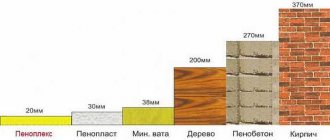Is it true that foam insulation is harmful to health?
Increasingly, modern builders recommend that buyers use penoplex to insulate their homes.
Penoplex with penoplex glue gained its popularity not so long ago, because it was invented only in the middle of the last century, but during this time it has spread throughout the world and began to occupy a position on a par with mineral wool, ordinary polystyrene foam and other well-known materials for thermal insulation.
Penoplex in original packaging
However, you can often hear that there is harm from penoplex, and very significant. Is it really? Let's try to figure it out.
Harm of penoplex: myth or reality?
- 1. What is extruded polystyrene foam
- 2. Harm of penoplex
Among all the modern thermal insulation materials on the market, Penoplex takes the lion's share, thanks to a large number of advantages. The strength of this material is much higher than that of ordinary polystyrene foam; it is not interesting to rodents. Due to its special anti-corrosion composition, penoplex can be used in all situations. In addition, this material is very light, which makes it possible to use it without harm for various structures.
As for the shortcomings, they also exist. Although many are mostly interested not in the disadvantages of penoplex, but in its harm when insulating the internal walls of a house. How harmful is extruded polystyrene foam? Can it be used as internal insulation for walls and floors inside the house? This is exactly what will be discussed in this article from the construction magazine samastroyka.ru.
What is extruded polystyrene foam
This insulation appeared relatively recently, around the middle of the last century. In Russia, the first company to produce this thermal insulation material began its activities in 1998. Therefore, we can say with confidence that Penoplex is a relatively new and, of course, modern thermal insulation material.
Penoplex is produced from polystyrene by extrusion - a technological process during which molten polystyrene is pressed through special molds. The output is a fairly dense material with a maximally homogeneous structure, having microscopic pores. It is due to this that penoplex does not absorb moisture, it has a high density and a sufficient degree of strength.
The main area of application of Penoplex is thermal insulation. Extruded polystyrene foam is used to insulate not only walls, floors and other surfaces in the house, but also roofs, foundations, and all kinds of building structures. This thermal insulation material copes well with its main task, but many developers are interested in how harmful it is in operation.
Why is polystyrene not dangerous?
To fully understand whether polystyrene is harmful to humans, you should at least superficially study the technology of its production. During the manufacture of the final product, a polymerization process occurs, due to which styrene is reliably retained in the thickness of the material. Even if we take into account that polymerization in production affects only 97% of the base, the remaining 3% is infinitesimal for poisoning humans and the environment.
It is the non-polymerized styrene residues that have become the reason for numerous myths that polystyrene is harmful and should not be used.
But it is also worth considering that during the process of using the material, a gradual but inevitable process of reverse depolymerization occurs, leading to the release of styrene. It can either accelerate or slow down under the influence of the following factors:
- temperature, especially high;
- ultraviolet and infrared radiation;
- oxygen;
- moisture.
It is for these reasons that insulation based on this material should be covered during construction and used only for external decoration of premises.
However, even taking into account the obvious toxicity of styrene, there is no clear answer to the question of whether polystyrene is dangerous to health. There are several reasons that made it safe:
- numerous components and additives used in production. They reduce the toxicity and volatility of styrene, as a result of which the building material becomes less harmful;
- lamination of products. The laminate applied to the entire surface of the product prevents the process of depolymerization and the release of toxic substances.
It is for this reason that the material laminated polystyrene is environmentally friendly - at the moment it is one of the safest thermoplastics.
But is polystyrene backing harmful? Not at all. Its production is carried out using a modified technology; in addition, the material is completely covered with a floor covering - laminate. And there is absolutely no harm from such a substrate.
It would be useful to consider which is more harmless: polystyrene foam or polystyrene. As studies have shown, the toxicity of both materials is at a minimum level and, subject to operating conditions, such materials cannot harm humans and the environment. Of course, like all thermoplastics, they cannot be called environmentally friendly, but there is no significant harm from them.
Harm of penoplex
The ancestor of extruded polystyrene foam can rightfully be considered ordinary polystyrene foam, which is made from polymers and gas fillers. There are many rumors about the dangers of polystyrene foam, but all of them are unconfirmed. The fact is that modern thermal insulation materials have been brought to an ideal state in their composition, and pose little threat to the human body.
Of course, no one is saying that penoplex is not harmful when it burns, or that polystyrene foam completely lacks a component such as styrene. The main thing here is the percentage of these most harmful substances, and in materials from well-known and certified manufacturers it is kept to a minimum. In this case, you need to take into account this fact that we are talking about large and well-known manufacturers of thermal insulation materials, which have made their name thanks to the high quality of their own products.
Such products are absolutely harmless when used even indoors. Plus, walls insulated with penoplex are still finished, so it’s pointless to talk about the dangers of this material or the release of something into the air. It’s a completely different matter when products from little-known manufacturers are chosen to insulate a house, and even at a low price. There is a kind of roulette here, since there are absolutely no guarantees about the quality of the purchased materials.
The main disadvantages of penoplex are its inability to withstand high temperatures and its rather expensive cost. In addition, the material is susceptible to chemical attack from solvents. In all other respects, it is excellent thermal insulation for walls and foundations, which is many times superior to polystyrene foam and some other thermal insulation materials.
What kind of insulation should it be?
Since there is no objective data about the allegedly harmful effects of penoplex on humans, we will figure it out ourselves.
When choosing insulation, many buyers, having familiarized themselves with the performance characteristics of the products of PENOPLEX SPb LLC, ask the question: “Is penoplex harmful to health?” There are no words, there is a lot of talk about the harmful effects of penoplex, but let's try to figure it out. The selected insulation for buildings or structures must meet the following requirements:
- the material used should not contain dust and small fibers, which confirms the unfoundedness of statements about the dangers of penoplex for the home, since these factors are absent;
- phenol-formaldehyde resins and similar harmful substances are absent in penoplex, which allows us to give a negative answer to the question: “Is penoplex harmful or not?”;
- whether penoplex is harmful to the environment and human health can be judged on the basis that no means are used in its production that destroy the Earth’s ozone layer;
- When the insulation is used from 50 degrees below zero to 75 degrees above zero, as recommended by the instructions for penoplex, there are no harmful emissions for humans, which is confirmed by the sanitary-epidemiological and environmental conclusion.
- Moisture resistance:
- Wetting of the insulation used in construction work leads not only to a decrease in the level of thermal protection, but also to the formation of fungi and mold, therefore, it is incorrect to talk about the harm of penoplex to human health, given its almost zero water absorption;
- modern penoplex insulation is so resistant to moisture that it is not afraid of either drainage water or swelling soils.
Is polystyrene foam harmful or not to human health?
What insulation should you use to avoid turning your home into a time bomb? After all, any thermal insulation material, with the exception of moss or flax, which is used to insulate wooden log houses, is a synthetic material, which means it contains toxic substances that are potentially dangerous and can harm human health. Particular discussions among users are caused by such questions as “is polystyrene foam harmful as insulation indoors” and “does the harm of extruded polystyrene foam exceed the harm caused by compressed polystyrene foam (ordinary polystyrene)”?
Is the buyer doing the right thing by giving preference to such an easy-to-use, relatively cheap and popular polystyrene foam?
It is dangerous for health to insulate a balcony from the inside with polystyrene foam
Is extruded polystyrene foam harmful to people?
We suggest you find out whether extruded polystyrene foam is harmful to human health? To do this, let’s break down the composition of the material into its components and consider the main dangerous component – styrene.
- Styrene – 0.05%. This figure is tens of times less than what is allowed by sanitary standards for residential premises in the Russian Federation. At the same time, the maximum permissible concentration of styrene in the EU countries is at the level of 0.002 mg/m3. But, do not forget that styrene tends to accumulate in the body. It demonstrates a cumulative effect (concentration increases 600 times over 20 years). And styrene is released already at a temperature of 25°C.
- The damage to polystyrene foam when exposed to high temperatures is another important aspect. In this case, toxic substances are released: vapors of styrene, benzene, carbon monoxide, carbon dioxide and soot. In this case, the combustion temperature of styrene is 1100°C. At this temperature, even metal melts, which leads to the destruction of the building.
- Time is another indicator. The decomposition period of expanded polystyrene is more than a century. During intensive use (20-25 years), its harm to health increases. After all, during this time, about 60% of the decomposed styrene is released.
- Oxygen, upon interaction with which formaldehyde and benzaldehyde are formed.
Why is styrene harmful?
- phenylethylene (styrene) accumulates in the liver and is not excreted from the body;
- adversely affects the functioning of the heart;
- exposure to styrene is critical for pregnant women, in particular for the fetus;
- entails irritation of the mucous membranes and respiratory tract.
Is it burning or not?
There is no doubt that modern insulating materials are susceptible to combustion. Consequently, there is a certain harmfulness of penoplex to the body during the combustion of this insulation. This releases carbon dioxide and carbon dioxide, which poses a danger to humans. Ordinary solid fuel stoves in rural areas are just as dangerous, because in the absence of draft, carbon monoxide can cause death or severe poisoning. When using insulation in the middle of a brickwork or outside, strengthening it on the walls, there is no need to talk about the health hazards of penoplex insulation, since the question: “Is penoplex harmful when burned?” It can be stated with full responsibility that burning penoplex is harmful, just like wood, MDF boards, and window structures. The statement that penoplex is harmful to the body, since when it burns, hydrocyanic acid and phosgene are released, is not true.
Today, when you can buy anything, the population has become interested in whether all of this variety is harmless to human health or not. In the modern world, the issue of environmental friendliness of manufactured products is strictly a question. Every adult knows that most building materials are accompanied by some diseases.
It may take years to understand for sure what exactly contributes to the occurrence of certain reactions, and decades to cure diseases. Therefore, it is recommended to study in advance the properties of materials, their effects on the human body, which are intended for use. This is especially recommended for people who already have prerequisites for the formation of allergic processes. Quite often, foam plastic is used to perform thermal insulation work. But before you insulate your own home using this material, it is worthwhile to figure out whether polystyrene foam is harmful when used as insulation.
Where is it safe to use polystyrene foam?
- in places where there are no potential sources of fire;
- in non-residential premises;
- use for external insulation of the base, foundation, insulation of a frame house with polystyrene foam from the outside.
As you can see, insulation inside the house is unacceptable, and polystyrene foam installed under the slate will not cause harm only if it is installed in a non-residential attic with good ventilation.
Let us note once again, answering the question of whether polystyrene foam is harmful indoors, it is not the styrene itself that is harmful, but its concentration. Expanded polystyrene is a completely safe decor, but is not recommended as insulation for residential premises.
Conclusion
Sellers of expanded polystyrene have the right to refer to GOSTs and SNiPs when offering their goods, because these standards do not regulate the environmental aspect of the use of this heat-insulating material.
Is penoplex harmful inside the house? Insulation of walls from the inside with penoplex and plasterboard
If you want to insulate the walls of your apartment or house with penoplex and plasterboard from the inside, then see the comments on this page about this insulation method. Insulating walls inside a house with penoplex and plasterboard is possible, but some nuances should be taken into account and not violate the work technology.
So, let's see what the pros and cons of this method are, and also take into account the specialists they leave under this publication.
Advantages of insulation from the inside
The biggest advantage when we insulate walls with penoplex and plasterboard from the inside of a room is the ability to carry out work in winter at negative outside temperatures.
Indeed, it’s winter outside, but it’s cold inside the house. And there is no way to wait for warmer weather to do any work outside.
In such conditions, it is quite possible to increase the level of thermal resistance of the walls by insulating them on the inside with extruded polystyrene foam.
The second big advantage of this method is that it is the only method that allows you to insulate individual apartments in an apartment building at any time.
Moreover, you can insulate the walls from the inside with penoplex and plasterboard yourself. And such work outside on the facade of a multi-apartment high-rise building would require complex lifting equipment and skills in high-rise installation work.
Disadvantages of internal wall insulation
The biggest disadvantage of insulating walls from the inside with penoplex and plasterboard is that we trap moisture inside the room. Extruded polystyrene foam has minimal vapor permeability. This means that all the moisture that should escape through the walls in the form of water vapor will remain in the premises.
However, there are two points that mitigate this disadvantage:
- This minus is valid only for vapor-permeable walls. These include wooden, aerated concrete, foam concrete, and brick walls.
If your house walls are made of concrete panels or expanded clay concrete blocks, then this minus does not matter to you - even before EPS insulation, your walls did not allow water vapor to pass through and did not “breathe.”
- Even in a house with “breathable” walls, you can avoid the appearance of moisture on the inner surface of the insulation sheets, under the gypsum board, if you reconfigure the ventilation system so that it removes a larger volume of air from the premises.
In this case, the volume of air that was previously removed through the walls of the house will be removed through exhaust ventilation.
Practical lesson on wall insulation and plasterboard covering
Next, we will look at how to insulate a wall with penoplex and cover it with plasterboard.
If you don’t understand something or have any questions, leave yours in the answer form at the bottom of the page. We hope that this material was useful to you.
What are the disadvantages of using a heat insulator?
Thermal insulator expanded polystyrene: benefit or harm
Table with characteristics of some thermal insulation materials.
Extruded polystyrene foam, like any other material, has its own pros and cons, which those who choose this insulation need to know about. It must be emphasized that not only the positive, but also the negative aspects of any building material are based solely on its properties.
Extruded polystyrene foam consists of granules that are glued together at very high temperatures. The granules contain air. In this case, the structure contains the main quality of the material. The air contained in the cells is maximally capable of retaining heat, so among all natural materials it will be one of the best.
The high level of performance of expanded polystyrene is combined with its high protective characteristics, which make it possible to protect the house from cold, the penetration of insects, bacteria, and moisture. This material is of no interest to insects because it is inedible.
The cellular structure gives the material almost everything, but it is worth highlighting the main thing - the material perfectly performs the main task, while at the same time solving the emerging difficulties associated with protection in conditions of high humidity or preventing the destruction of wooden elements of houses from insect pests.
Is extruded polystyrene foam harmful indoors? What is polystyrene foam or expanded polystyrene?
First you need to understand what polystyrene foam is and how it behaves under various influences. And understand whether polystyrene foam is harmful to health?
Expanded polystyrene is a gas-filled material. They are made by steam heating polystyrene granules. These granules are first filled with gas. The gas used is different: in ordinary polystyrene foam, natural gas is used, in fire-resistant foam, carbon dioxide is used. When heated, the gas expands, and the granules increase many times in size (15 - 30 times the original).
Polystyrene foam poisoning. Is polystyrene foam as insulation harmful to human health?
To retain heat in a private house or apartment, external or internal wall insulation is performed. It is important that all materials used in the construction or renovation process are environmentally friendly.
For example, polystyrene foam is used as insulation. How safe is it for humans and can it be used for insulation?
Is polystyrene foam as insulation harmful to human health?
Many users, in particular owners of apartments on the upper floors, prefer to carry out thermal insulation work from the inside of the room. What does this mean? Which insulation material should you prefer and what is the difference between polystyrene foam and polystyrene? Is polystyrene foam harmful to human health? If it is dangerous, then why and what are the harmful properties of polystyrene foam?
What harmful substances does foam release?
To determine whether polystyrene foam emits harmful substances, you need to consider the composition of the foam; among the harmful components it includes:
- styrene (0.01-0.2%) is a substance harmful to human health that can be released into the air for another 20 years after installing the insulation. Released when the temperature exceeds 25 °C;
- phenol is another chemical compound in foam that is released when exposed to direct sunlight or at temperatures exceeding 20 ° C;
- formaldehyde (formaldehyde, methanal) is a toxic gaseous substance that is released at high temperatures (over 160 ° C).
It should be remembered that substances released by polystyrene foam tend to accumulate, causing deterioration in the health of people living in the room.
So, on the one hand, the balance is: ease of installation, convenience of further finishing, low cost, and on the other hand, the safety of the house and its occupants.
Is polystyrene foam harmful as insulation?
It is possible to answer unequivocally only taking into account the location of its installation and operating conditions, in particular the temperature regime.
When talking about the harmfulness of polystyrene foam, you need to consider at what temperature the foam releases harmful substances. As already noted, styrene and phenol are released at room temperature.
Many are convinced that the harm of polystyrene foam manifests itself regardless of the installation location. However, is foam plastic harmful indoors or is there no health risk when installing it on interior walls? Experts say that polystyrene foam installed on external walls is absolutely safe, since the small amount of vapors of harmful substances that can penetrate through the ventilation, even if accumulated, cannot cause significant harm.
How to eliminate the harmful effects of polystyrene foam
You can reduce or neutralize the harm of polystyrene foam as follows:
- do not install in residential premises, inside rooms of a house or apartment;
- when insulating walls in a house, attach polystyrene foam only to external walls and install ventilation correctly;
- if it is necessary to install foam plastic on the ceiling, this should be done from the attic side (provided that it is non-residential). Installation on the balcony ceiling (from the inside) is also excluded;
- do not purchase polystyrene foam produced by handicraft methods. Each seller must have a certificate confirming the styrene content;
- Use only for its intended purpose, namely as external insulation. The construction of playhouses for children is, of course, unacceptable. But is polystyrene foam dangerous for animals and birds, in particular for chickens (who love to peck at it)? Manufacturers say no. After all, the lifespan of chickens is short and harmful substances simply do not have time to accumulate in their bodies.
The influence of polystyrene foam on human health
Questions about whether polystyrene foam is harmful to health or not have worried consumers almost from the very beginning of its use. Each new finishing and building material based on foam plastic caused a renewal of these disputes.
Proponents of the use of expanded polystyrene cite the research of scientists - chemists, physicists and materials scientists - as a safety argument. Expanded polystyrene, without external influences on it, practically does not interact with the environment.
Its molecular structure is very stable. The experiments described above show that under normal human conditions, polystyrene foam does not emit any harmful substances. Actually, it does not release any substances.
If you use polystyrene foam at temperatures from -40°C to +40°C, then you don’t have to worry about the harmful effects of polystyrene foam on health.
Opponents of the use of expanded polystyrene claim the possibility of styrene release. Even if not under ordinary, but under extreme conditions. Extreme conditions refer to exposure to high temperatures. Indeed, when burned, polystyrene foam, like many other substances, releases a large amount of toxic substances, among which styrene is considered especially toxic.
Effect of styrene on humans:
- dizziness;
- irritation of the mucous membranes of the eyes;
- high concentrations lead to lung damage and even fatal poisoning;
- the functioning of the kidneys, liver, and hematopoietic system is disrupted;
- oncology.
It is worth recalling that the separation of styrene from polystyrene foam under normal human operating conditions is impossible. Styrene is released only when polystyrene foam burns.
The flammability of the initially created polystyrene foam was quite high. At temperatures above 210 °C, the foam was able to independently support surface combustion and spread fire. That is why fire retardants (substances that inhibit ignition and flame spread) are now used for the production of construction and finishing polystyrene foam.
Thanks to this, it was possible to reduce flammability and increase the ignition temperature to 440 °C. In addition, most modern polystyrene foam products do not allow flames to spread and do not support spontaneous combustion.
The harmfulness of highly concentrated styrene to human health is great: it should be remembered that the release of styrene from polystyrene foam is unlikely from a chemical and physical point of view, especially if operating rules are followed and measures are taken to prevent fire.
It must be said that, like many other substances that are dangerous in large doses, but harmless in small doses, styrene is naturally found in many products that we use every day - coffee, tea, cinnamon, cheese, strawberries and so on.
Melting polystyrene foam
An exception to the permissible scope of use of expanded polystyrene is roof insulation. Yes, materials based on polystyrene foam are recommended by manufacturers as excellent roof insulation, but we must remember that a roof, especially a metal one, can get very hot under the sun. Despite the fact that the decomposition of polystyrene foam begins at a temperature significantly higher than that to which the roof can be heated naturally, the danger of styrene release will still exist. To insulate the roof, it is better to use mineral wool and similar materials.
The harm of expanded polystyrene to human health may also be associated not so much with the qualities of the material, but with its improper use in finishing. Expanded polystyrene is a very popular thermal insulator, but at the same time it does not allow steam and moisture to pass through. It happens that people, out of ignorance or out of economy, insulate the walls between the apartment and the street from the inside with sheets of expanded polystyrene.
